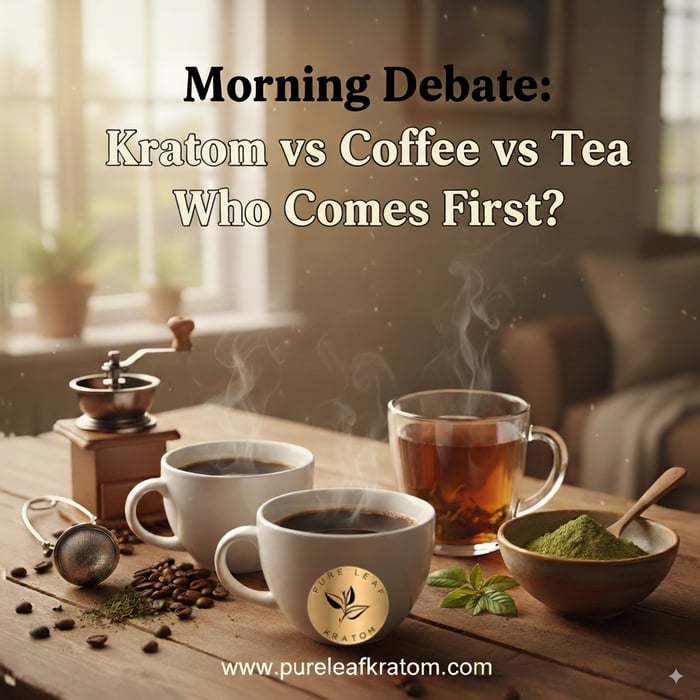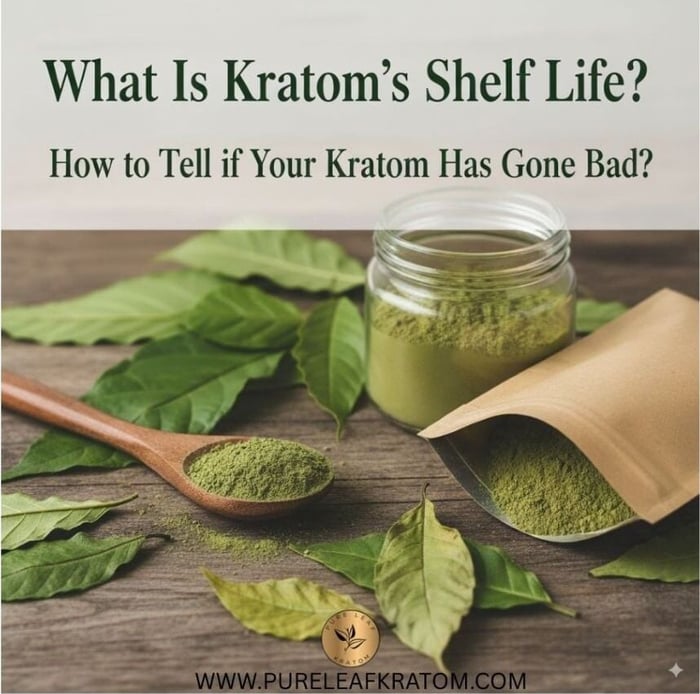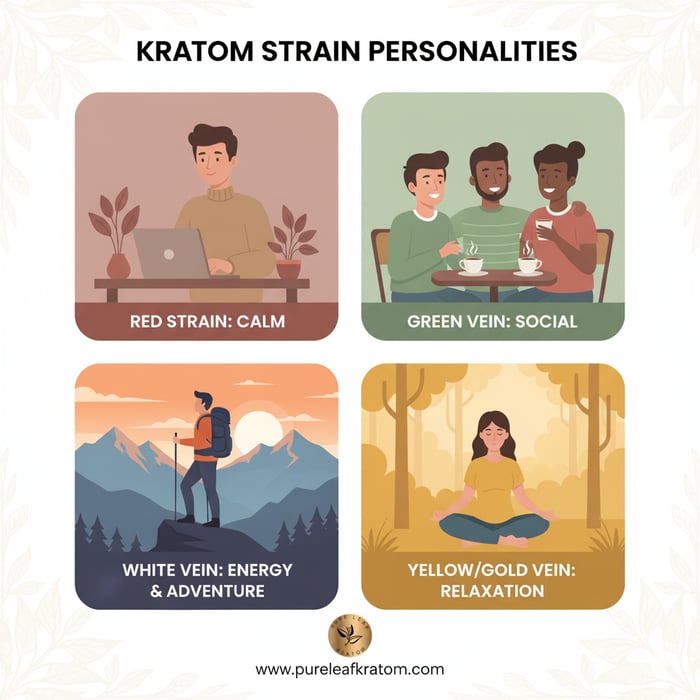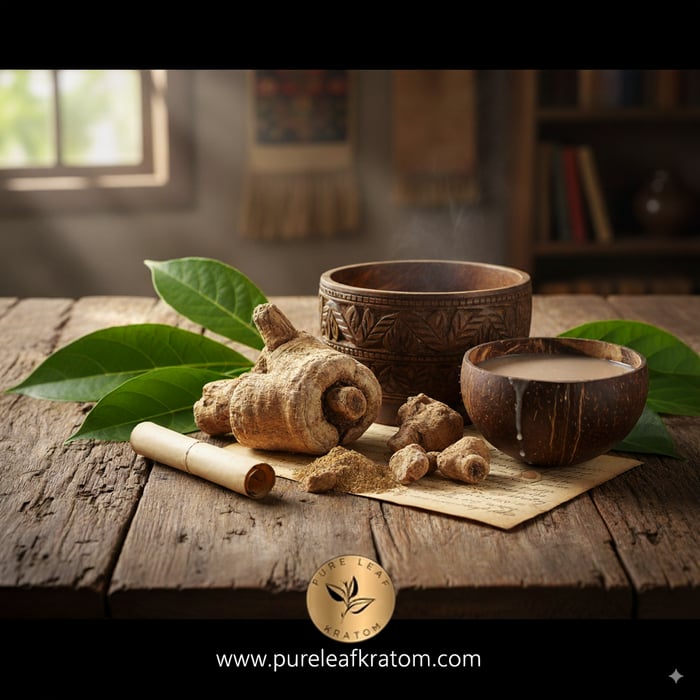
Morning Debate Kratom vs Coffee vs Tea Who Comes First?
Table of Contents
Introduction: The Power of the Morning
Morning has always carried a special kind of energy, a sense of renewal that marks the beginning of possibility. Across the world, people have built traditions around their mornings, finding comfort in small rituals that help them ease into the day. These rituals are not just about consumption they’re about grounding, preparing, and creating a sense of rhythm that can influence everything that follows.
For centuries, beverages have been at the center of these rituals. Some people wake up to the familiar, almost intoxicating aroma of freshly brewed coffee filling the kitchen. The sound of beans grinding, water boiling, and the drip of a pot signals that the day has officially begun. Coffee isn’t just a drink it’s a statement that the morning is here.
Others prefer the calming touch of tea. Watching delicate leaves swirl in hot water and breathing in fragrant steam is a slower, more meditative process. Tea drinkers often describe it as a way to set a peaceful tone, making each sip feel like a quiet pause before the busyness of the day. With countless varieties and cultural traditions tied to tea, it has become more than a beverage it’s a symbol of balance, harmony, and connection.
And now, another contender is stepping into the morning spotlight: kratom. Once a hidden treasure of Southeast Asia, kratom is rapidly gaining recognition around the globe. Its earthy flavor, versatile formats, and growing community of enthusiasts make it a fascinating alternative to traditional morning drinks. Whether in powder, tablet, or shot form, kratom is finding its place alongside coffee and tea in the conversation about what fuels the start of a new day.
Each of these choices kratom, coffee, and tea comes with its own history, cultural weight, flavor profile, and unique experience. They all have something special to offer, which sparks the big question: which one truly wins the morning battle?
Is it the bold intensity of coffee, the calming versatility of tea, or the innovative rise of kratom? The answer isn’t simple, because the winner depends on what you want your morning to be.
In this guide, we’ll take a deep dive into the origins, rituals, flavors, and overall experiences that these three morning staples bring to the table. By the end, you’ll have a clearer picture of which one might deserve the crown in your personal lineup or whether the real victory lies in appreciating the strengths of each.
A Tale of Three Leaves
It’s fascinating how three completely different plants growing in distant parts of the world have each carved out a place in morning traditions. Despite their differences, they share a common thread: all three begin as leaves.
Kratom: The Evergreen of Southeast Asia
Kratom comes from the Mitragyna speciosa tree, a tall evergreen native to the lush landscapes of Thailand, Malaysia, and Indonesia. Its broad, glossy leaves have been part of daily life in these regions for centuries. Traditionally, kratom leaves were chewed fresh or brewed into a simple tea. Farmers and local communities saw the plant not just as a resource, but as part of their cultural rhythm.
As kratom spread into modern markets, its forms multiplied. Today, it can be found as finely milled powders, pressed tablets, or even flavored shots that mask its naturally earthy bitterness. Each form reflects a step in kratom’s evolution where tradition meets convenience while keeping its roots tied to the tropical soils of Southeast Asia.
Coffee: From Seed to Global Icon
Coffee, unlike kratom or tea, begins not with a leaf but with a seed the roasted bean of the coffee cherry. Origin stories point to Ethiopia, where legend tells of a goat herder noticing his animals becoming lively after eating red coffee berries. From there, coffee’s journey carried it to Yemen, then across the Middle East, Europe, and eventually the entire globe.
Over the centuries, coffee grew from a humble crop into a cultural and economic powerhouse. Coffeehouses became centers of conversation and creativity, while trade routes built entire industries around its beans. Today, whether it’s a carefully crafted pour-over or a quick grab-and-go latte, coffee remains deeply woven into the morning fabric of millions worldwide.
Tea: A Leaf of Endless Expression
Tea has an equally rich story, rooted in the Camellia sinensis plant. What makes tea unique is how much variety can emerge from the same leaf, depending on how it’s processed. Black tea is fully oxidized, green tea is lightly heated to preserve freshness, oolong balances somewhere in between, and white tea remains the most delicate of all.
Across cultures, tea has taken on many forms. In China and Japan, it’s steeped in ceremony, representing patience and mindfulness. In India, chai spices up the day with bold, comforting flavors. In England, tea time became a refined social ritual. No matter where you go, a cup of tea often symbolizes more than just a drink it’s a pause, a gathering, or a comfort.
One Thread, Many Paths
Kratom, coffee, and tea may come from different plants and different corners of the world, but their paths share a striking similarity. Each starts as a leaf (or in coffee’s case, a seed), is shaped by human hands, and travels through culture and time before finding its way into the morning ritual.
Three plants. Three histories. Three journeys from leaf to cup. And yet, all three remind us of something simple and universal: the human desire to greet the day with a drink that connects us to nature, to tradition, and to ourselves.
The Ritual: More Than Just a Drink
Morning beverages are about more than hydration or flavor—they’re about ritual. That ritual can bring comfort, mindfulness, or even excitement. It’s not just about what’s in the cup, but how the cup is made, when it’s enjoyed, and the meaning it carries for the person holding it. Each morning drink creates a rhythm, a pause, or a spark that helps set the tone for the rest of the day.
Kratom Rituals
Kratom’s preparation depends heavily on personal preference, which makes it one of the most customizable rituals. Some people enjoy measuring out a spoonful of powder and mixing it into juice or smoothies, masking its earthy flavor while creating something unique each morning. Others take the simpler route ready to drink shots that pack convenience and flavor into a small bottle. Tablets and capsules bring another level of ease, offering a no-fuss way to keep the ritual streamlined.
This variety gives kratom rituals a sense of playfulness and discovery. For someone new, mornings might feel like an experiment testing flavors, trying different blends, or finding the preparation style that fits their routine best. Over time, this exploration can settle into a comforting ritual that feels intentional. There’s something grounding about starting the day by making a choice whether to sip slowly from a mug, swallow a tablet, or grab a quick shot on the go.
Coffee Rituals
Coffee, on the other hand, is almost synonymous with ritual. For many, it’s not even about the drink itself but about the process of making it. Grinding beans, listening to the rhythmic hum of a brewer, or carefully pouring hot water over a filter can feel almost meditative. Each step becomes part of a performance that signals the transition from sleep to wakefulness.
Some embrace this ritual as a quiet, solitary moment just them, their mug, and the comforting aroma filling the kitchen. Others make coffee a communal event, preparing it for family members or sharing it with friends before the day begins. In cafés, the ritual takes on a social dimension, where people gather, chat, and enjoy a sense of community over steaming cups.
Modern coffee culture has added even more layers. Latte art turns foam into a canvas, while specialty brewing methods like French press, AeroPress, or cold brew allow enthusiasts to fine-tune their morning experience. The ritual of coffee is adaptable; it can be as simple as pressing a button or as elaborate as a ten-minute brewing ceremony.
Tea Rituals
Tea holds some of the most deeply rooted rituals in human history. In Japan, the tea ceremony is an art form, emphasizing harmony, respect, and mindfulness in every deliberate movement. In China, gongfu tea ceremonies elevate steeping to a practice of precision and elegance, where every pour is intentional. In Britain, the tradition of afternoon tea became a cornerstone of culture, offering not just refreshment but also a symbol of refinement and social connection.
Even outside of these formal traditions, tea has a way of slowing life down. There’s something inherently grounding about boiling water, selecting a blend, and watching the leaves or even just a tea bag unfurl and infuse the liquid. Unlike coffee, which often feels like a jolt into motion, tea encourages pause. It’s patient by nature, asking you to wait a few minutes before it’s ready, and rewarding you with warmth and subtlety.
This patience is part of tea’s charm. For many, it’s the beverage of reflection the moment when they gather themselves before diving into the demands of the day. Whether enjoyed in silence or shared with company, tea rituals embody a balance of calmness and intention.
Which Ritual Wins?
That depends on what you seek at the start of your day. Kratom rituals bring variety and a sense of personal choice, appealing to those who enjoy experimenting or tailoring their mornings. Coffee rituals bring intensity, energy, and community, perfect for people who love routine paired with a burst of action. Tea rituals bring calmness, patience, and reflection, reminding us to slow down before the day accelerates.
Each drink’s ritual carries its own charm. And in the end, the winner isn’t universal it’s personal. The real victory lies in the ritual you choose, the one that transforms your morning into something more than just another day.
Flavor Profiles: A Spectrum of Experiences
Taste is deeply personal, and each contender brings something distinct to the table.
Kratom’s Flavor
Kratom has a naturally earthy and slightly bitter profile. Some embrace it in its raw form, while others prefer flavored products that mask the herbal tones. Today, innovations such as chewable tablets and fruity shots make kratom accessible to those who might find the traditional taste too strong.Coffee’s Flavor
Coffee delivers boldness. Its flavor ranges widely depending on the roast. Light roasts can be bright and fruity, medium roasts balanced and smooth, and dark roasts smoky and rich. Add milk, sugar, or syrups, and coffee becomes one of the most versatile and customizable beverages in the world.Tea’s Flavor
Tea offers endless variety. Black tea can be robust and malty, green tea vegetal and grassy, oolong floral and complex, and white tea light and delicate. Herbal teas add even more possibilities, from chamomile’s sweetness to hibiscus’s tart punch. Tea is both simple and sophisticated, giving drinkers room to explore.
The spectrum of flavors ensures that no matter your taste preferences earthy, bold, or delicate one of these drinks will fit the bill.
Energy & Morning Mindset
Each beverage also brings its own kind of energy to the morning.
Kratom is often chosen by those seeking an alternative to traditional morning beverages. Different strains and formats are explored for their distinct profiles, allowing enthusiasts to tailor their experience.
Coffee has long been the go-to for a strong kick. Its sharp, immediate effect is part of why so many people can’t imagine mornings without it. Coffee is fast, bold, and commanding.
Tea provides a smoother, lighter path. Many describe tea as offering a gentle lift, less intense than coffee but still effective at setting the tone for the day.
This diversity makes the “morning battle” more of a personal preference than a clear victory.
Culture and Community
Beyond taste and ritual, each beverage carries a culture that enriches its story.
Kratom Culture
While still emerging, kratom culture is vibrant and growing fast. Online communities, blogs, and retailers have created spaces where people share experiences, favorite strains, and product recommendations. It represents a new wave of exploration, with a sense of curiosity and discovery.Coffee Culture
Coffeehouses are iconic gathering spots worldwide. From Parisian cafés to Italian espresso bars to American coffee chains, coffee culture is deeply ingrained in modern life. Latte art, third-wave roasters, and specialty drinks showcase how coffee is both a daily necessity and a creative industry.Tea Culture
Tea traditions are ancient and diverse. Chinese tea ceremonies, Japanese matcha rituals, British tea times, and Moroccan mint tea all highlight the global significance of this leaf. Tea is steeped in history, representing hospitality, connection, and cultural identity.
When it comes to cultural influence, coffee and tea hold centuries of history but kratom is quickly crafting a modern identity that sets it apart.
Convenience Factor
Morning routines often depend on time, and convenience matters.
Kratom can be as quick as taking a tablet or drinking a shot. Powder preparation requires a bit more time but allows for flexibility.
Coffee preparation ranges from instant packets to elaborate espresso machines. The spectrum is wide, from seconds to several minutes.
Tea is straightforward. A tea bag in hot water takes almost no time, while loose-leaf preparation requires more effort but can feel rewarding.
In terms of sheer convenience, kratom shots and tea bags tie for the fastest options, while coffee offers the broadest spectrum of complexity.
Variety and Innovation
One of the most exciting parts of these three contenders is how much variety they bring.
Kratom is in its innovative stage. Powders, tablets, shots, chewables, flavored blends creativity is driving new ways to enjoy it.
Coffee reinvents itself constantly. Cold brews, nitro infusions, seasonal flavors, and artisanal roasts keep coffee culture fresh.
Tea has thousands of varieties, and modern blends continue to experiment with flavor, function, and presentation. Bubble tea, chai lattes, and iced teas expand its reach.
All three shine in this category, but kratom stands out for how rapidly new products are appearing on the market.
Price Points
Cost can also play a role in the morning battle.
Kratom prices depend on the form. Bulk powder is cost-efficient, while tablets and shots cost more but offer convenience.
Coffee can be budget-friendly at home but expensive at cafés. Specialty coffee habits can add up quickly.
Tea is often the most affordable, especially when bought loose-leaf or in bulk. Premium teas, however, can be costly.
If budget is the deciding factor, tea generally wins, but kratom powder also competes well for value.
The Verdict: Who Wins the Morning Battle?
So, who deserves the crown?
Coffee is the champion of boldness and ritual.
Tea is the master of balance and tradition.
Kratom is the newcomer with versatility and innovation.
The truth is, there may never be a single winner. Instead, each beverage offers its own kind of victory, depending on the morning you want. Some days call for intensity, others for calmness, and still others for experimentation.
Final Thoughts
Mornings are deeply personal, and so are the rituals that shape them. They are the quiet moments that set the rhythm for everything that follows, the first choices that guide how the day will unfold. Whether it’s the robust aroma of freshly brewed coffee filling the air, the delicate elegance of tea leaves slowly unfurling in steaming water, or the earthy innovation of kratom prepared in one of its many modern forms, each option brings something unique to the table.
So which truly wins the morning battle? The real answer is simpler and perhaps more satisfying than choosing a single champion: they all do, depending on what you’re looking for.
Coffee often shines on mornings that demand boldness and drive. Its intensity pairs well with busy, energetic days when momentum matters most. Tea, with its calm and graceful nature, offers something entirely different. It can be a gentle grounding force, encouraging reflection before the day accelerates. Kratom adds yet another dimension a versatile and innovative alternative for those who like variety, experimentation, and the chance to start their mornings in a way that feels both intentional and fresh.
Instead of seeing them as rivals, the beauty lies in variety. Life is full of different seasons, moods, and moments. Some mornings call for the lively spark of coffee, others for the patience of tea, and still others for the exploratory spirit of kratom. Having all three at your disposal means you don’t have to choose you can let your mornings evolve with your needs, preferences, and curiosities.
In the end, the real winner isn’t coffee, tea, or kratom it’s you. You get to decide what your mornings look like, how they feel, and what ritual best reflects the day you want to create. Each cup, whether bold, delicate, or earthy, is an opportunity to connect with yourself, to pause with intention, and to step into the day on your own terms. That freedom to craft mornings that fit your lifestyle, preferences, and rituals is the ultimate victory.
FAQs
1. Why are mornings so important in daily rituals?
Mornings set the tone for the entire day. The rituals and beverages we choose—whether coffee, tea, or kratom—help ground us, spark energy, or create calmness before the day unfolds.
2. What makes coffee such a popular morning drink?
Coffee is bold, aromatic, and energizing. Its preparation process from grinding beans to brewing has become a ritual for millions worldwide. Beyond taste, coffee culture thrives in cafés, social gatherings, and creative routines, making it a staple for busy mornings.
3. How does tea compare to coffee in the morning?
Tea offers a gentler, more reflective start to the day. Its countless varieties black, green, oolong, white, and herbal make it versatile. Tea is deeply tied to cultural traditions and often represents balance, calmness, and mindfulness.
4. What is kratom, and how does it fit into morning routines?
Kratom comes from the evergreen Mitragyna speciosa tree of Southeast Asia. Traditionally brewed as tea or chewed, it has evolved into modern forms like powders, tablets, and ready-to-drink shots. Many people see it as an innovative alternative to coffee or tea, offering versatility and a fresh way to begin the day.
5. How do the rituals differ between kratom, coffee, and tea?
Kratom: Highly customizable—mixing powders, sipping shots, or taking tablets.
Coffee: Rich in ritual—grinding, brewing, or enjoying in a café setting.
Tea: Steeped in ceremony and patience—often symbolic of mindfulness and calm.
6. Which one has the best flavor?
It depends on your taste:
Kratom is earthy and slightly bitter, often paired with flavored products.
Coffee is bold and ranges from fruity light roasts to smoky dark roasts.
Tea is endlessly diverse, from robust black teas to delicate white teas and fruity herbal blends.
7. What about convenience who wins there?
Kratom: Fast options like tablets or shots are highly convenient.
Coffee: Ranges from instant mixes to elaborate espresso routines.
Tea: Very quick with tea bags, though loose-leaf requires more effort.
8. Which drink has the strongest cultural influence?
Coffee: Coffeehouses shaped art, politics, and social life across centuries.
Tea: Ancient traditions in Asia, Europe, and beyond make it timeless.
Kratom: Still emerging but rapidly building a vibrant global community.
9. Is there a “winner” in the morning battle?
Not exactly. Each beverage offers something unique:
Coffee for boldness and energy.
Tea for calmness and tradition.
Kratom for innovation and variety.
The best choice depends on the type of morning you want.
10. Do I need to choose just one morning drink?
Not at all. Many people enjoy rotating between them. Some mornings call for the lively spark of coffee, others for the patience of tea, and still others for the versatility of kratom. The real victory is having the freedom to match your ritual with your mood and goals.




